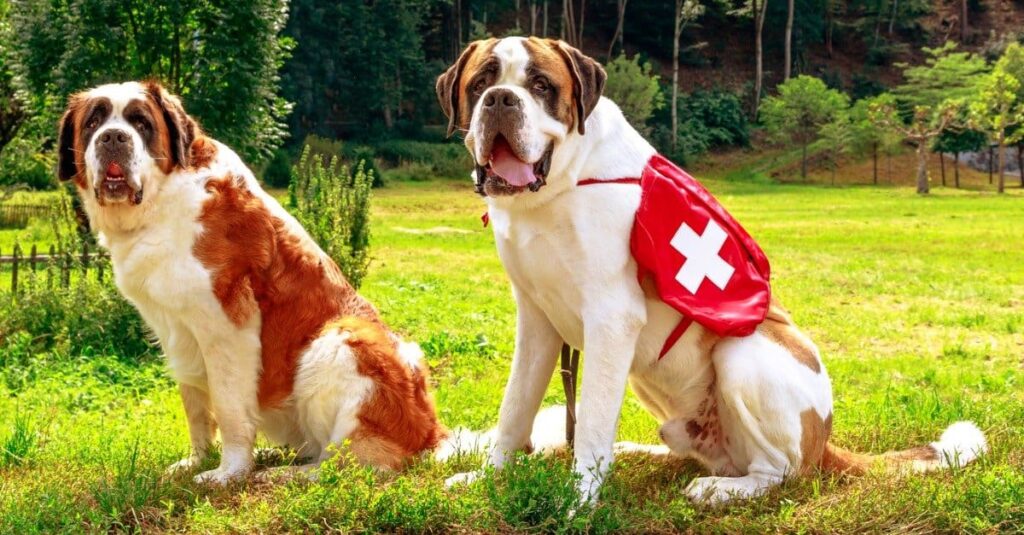In the quiet, picturesque town of Castle Rock, the chilling story of Cujo unfolds. Stephen King may not remember writing his famous novel, but audiences will never forget the terror of watching this innocent pup-turned-killer on the big screen in 1983. Cujo takes us on a suspenseful journey filled with fear, loyalty, and survival, as man’s best friend descends into madness through no fault of his own. You may find yourself wondering, what kind of dog is Cujo? How did such a sweet and friendly pup become so aggressive? And most importantly, is Cujo’s behavior at all normal for his breed? Let’s dive in and discover the answers to these important questions!
Who Is Cujo?

Stephen King wrote his novel while struggling with an alcohol addiction.
©Jacket design by R. Adelson, Jacket illustration by Steven Stroud / Public domain via Wikimedia Commons – License
Bestselling author and master of horror, Stephen King, unleashed his terrifying masterpiece, Cujo, upon the world in 1981. Merely two years later, this bone-chilling tale was brought to life on the silver screen. Cujo takes readers and viewers on a psychological thrill ride, delving into the unsettling descent of the titular character. Once a gentle and loving family dog, Cujo transforms into a rabid and murderous beast, leaving us with a very haunting afterimage.
One of the reasons this story is so unsettling is that the dog is not to blame — he was merely a victim of a bite from a rabid bat (or potentially a supernatural possession).
What Kind of Dog Is Cujo?

Saint Bernards can grow to stand 26 to 30 inches tall at the shoulders.
©Rita_Kochmarjova/Shutterstock.com
Cujo is a Saint Bernard. However, the film’s dog trainer, Karl Miller, wanted to go with a different breed. Saint Bernards can be very difficult to train for stunt work due to their size, strength, and short attention spans. These massive dogs can weigh up to 180 pounds! They are also known for having an independent streak, having been bred to work alone in the snowy mountains. In addition, Saint Bernards are very sensitive dogs and will shut down if treated harshly or yelled at.
However, the film’s director chose to stick to the novel’s portrayal of Cujo as a Saint Bernard, employing several different dog actors to portray Cujo. Each dog was assigned a specific role or action. For example, one dog was responsible for scenes involving running, while another was responsible for barking on command. For the more dangerous scenes, filmmakers used a mechanical dog. In addition, stuntman Gary Morgan even wore a custom-made Saint Bernard suit and portrayed Cujo in some of the film’s scenes! The crew also had a backup plan, which included a dog suit and a Labrador retriever.
Are Saint Bernards Naturally Aggressive?

Saint Bernards were deployed through the Alps to help with mountain rescues.
©iStock.com/bennymarty
No, Saint Bernards are not naturally aggressive at all! In fact, the Saint Bernards who portrayed Cujo in the film were so friendly that filmmakers had to tie their chronically wagging tails down with fishing wire!
Saint Bernards are sensitive dogs that have been bred and trained to care for and rescue travelers in the Alps. They are extremely patient and gentle, and they typically have easygoing personalities. Although they are large and muscular, Saint Bernards don’t like running around much. They much prefer being with their favorite humans and especially love to lounge around and cuddle.
What Are Saint Bernards Really Like?

Saint Bernards are happy dogs who love to lounge around the house and sleep most of the day.
©Aneta Jungerova/Shutterstock.com
Although Cujo may make Saint Bernards appear to be fearsome, terrifying dogs, in real life they are exactly the opposite! Saint Bernards are extremely affectionate and make great family dogs. They are patient and gentle and are quite fond of children. Although they are enormous creatures, Saint Bernards are the gentlest of giants in the dog world. In fact, one of the greatest threats they pose is that they may accidentally knock small children over due to their incredible size.
Despite their large size, however, Saint Bernards do not require a ton of exercise and don’t eat nearly as much as you might expect. However, they are heavy shedders with thick double coats of fur, so they require regular brushing and de-shedding. In addition, they do need proper socialization and training to prevent fearfulness and territorial behavior.
How Do Dogs Get Rabies?

The rabies virus resides in the saliva of infected animals.
©EzumeImages/iStock via Getty Images
Rabies typically affects wild animals, but it can potentially spread to dogs through bites and other forms of contact. The rabies virus resides in the saliva of the infected animal. It can enter a dog’s bloodstream through a bite or puncture wound. This is how Cujo ended up with rabies in the book and in the film adaptation.
Although less common, dogs can also get rabies through contact with infected saliva without a bite. For example, if an animal infected with rabies were to lick an open wound or the dog’s mouth, nose, or eyes, it could potentially transfer the virus into the dog’s body. Another rare method of transmission is through the digestive system. This can occur if a dog eats the tissue or remains of an infected animal.
If your dog has had an encounter with a potentially rabid animal, it’s crucial to get them to a veterinarian right away. Taking action as soon as possible greatly increases the chances of a positive outcome. By seeking immediate veterinary intervention, your pet can get the necessary care and attention they need to combat this serious disease.
The best way to prevent rabies from threatening your dog, however, is through regular and up-to-date vaccinations. Making sure your dog has a current rabies shot is an easy way to keep them safe from this dangerous disease. In addition to up-to-date vaccinations, keeping your dog on a leash — especially in areas with wild animal populations — and supervising them when they are outside greatly reduces encounters with potentially rabid animals.
Are Rabid Dogs Really Aggressive?

Thanks to the rabies vaccination, this disease can be prevented with a quick and simple shot.
©Teka77/iStock via Getty Images
Due to media portrayals, the iconic symptom of rabies is aggression — but not all dogs with rabies actually exhibit aggressive behavior! There are two types of rabies that can affect dogs, and each dog will respond differently.
What we usually see depicted in the media — such as in movies like Cujo or Old Yeller — is called “Furious Rabies”. This rabies variant often causes dogs to be more aggressive for no apparent reason. They may also exhibit unpredictable behavior and excitability. They may even snap, bite, growl, or try to attack unfamiliar people or animals without being provoked. Other signs include sensitivity to lights and movement, agitation, and irritability. Some dogs with rabies may even act more impassive, while others become more affectionate and clingier.
The second type of rabies is called “Paralytic Rabies”. Instead of aggressiveness, dogs with paralytic rabies often experience muscle weakness, difficulty swallowing, paralysis, excessive drooling, disorientation, or lethargy.
Final Thoughts

Saint Bernards are calm and gentle dogs.
©iStock.com/slowmotiongli
Any dog — regardless of breed — can get rabies. This disease affects the nervous system and can cause aggression and other abnormal behaviors. While rabies is a serious disease, don’t worry — dogs with rabies don’t go on killing sprees or hunt people down like some terrifying monster from a horror film. In addition, rabies is easily preventable with regular vaccines.
It’s important to remember that Cujo is a fictional, psychological thriller. It is a very creative story about a rabid dog who just so happened to be a lovable Saint Bernard — and in real life, Saint Bernards do not act at all like Cujo. These gentle giants are total sweethearts, known for their large size and kind hearts.
The photo featured at the top of this post is © Jacket design by R. Adelson, Jacket illustration by Steven Stroud / Public domain via Wikimedia Commons – License / Original
Ready to discover the top 10 cutest dog breeds in the entire world?
How about the fastest dogs, the largest dogs and those that are -- quite frankly -- just the kindest dogs on the planet? Each day, AZ Animals sends out lists just like this to our thousands of email subscribers. And the best part? It's FREE. Join today by entering your email below.
Thank you for reading! Have some feedback for us? Contact the AZ Animals editorial team.







